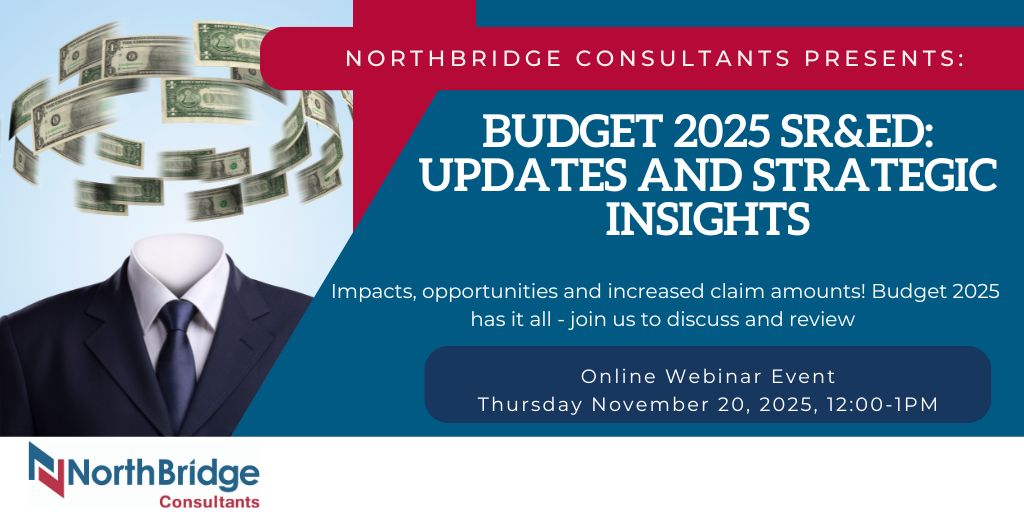A Clear Signal for Innovation and Investment
Budget 2025, titled “Canada Strong,” wasn’t just about fiscal anchors and public spending; it delivered a clear, tangible message to Canadian businesses: Invest in Canada, and we will maximize your savings. The federal government has launched a concerted, strategic effort to boost domestic productivity and global competitiveness using the tax system.
The most exciting news for forward-thinking companies lies in the new incentives bundled under the banner of “Supercharging Growth,” particularly the confirmed and enhanced changes to the Scientific Research and Experimental Development (SR&ED) program and the new “Super-Deduction” initiative. These measures are designed to immediately improve cash flow, reduce the cost of capital, and reward businesses that take risks and drive innovation in Canada.
The window for maximizing these benefits is now. Here is The North Group’s definitive breakdown of the changes that matter most to your bottom line, starting with the headline SR&ED enhancement.
Direct Boost to SR&ED: The $6 Million Threshold
The Scientific Research and Experimental Development (SR&ED) program has long been Canada’s single most important incentive for business innovation, currently providing $4.2 billion in annual support. For Canadian-Controlled Private Corporations (CCPCs), Budget 2025 delivers the most significant cash flow expansion in over a decade, sending a clear, positive signal to innovative companies.
The federal government has cemented its previous commitments and gone even further. The annual expenditure limit on which CCPCs can earn the maximum 35% refundable Investment Tax Credit (ITC) is now set to $6 million.
This massive increase from the prior $3 million limit (and the recently proposed $4.5 million in the FES 2024) allows qualifying CCPCs to claim refundable credits on a substantial additional $3 million in R&D spending. This means hundreds of thousands of new dollars returning directly to fund your next wave of innovation, quickly offsetting your R&D investment costs.
Program Enhancements and Administrative Clarity
The enhancements don’t stop at the dollar limits. The government has simultaneously streamlined program access and restored key eligibility rules. This combination of increased financial support and reduced administrative friction is a strong move toward predictability and efficiency.
| SR&ED Enhancement: The New Landscape | Details from Budget 2025 | Impact for Innovators |
| Increased Enhanced Credit Expenditure Limit | Proposed to be further increased from the previously announced $4.5 million to $6 million. Effective for taxation years beginning on or after December 16, 2024. | Access to a higher 35% refundable rate on a much larger pool of R&D expenses. |
| Increased Taxable Capital Thresholds | Increased the prior-year taxable capital phase-out thresholds from $10 million and $50 million to $15 million and $75 million. | Extends eligibility for the enhanced 35% refundable credit to larger CCPCs and increases the amount of expenses eligible for the 35% rate. |
| Eligibility of Capital Expenditures | Restored eligibility for SR&ED capital expenditures. | Allows companies to claim R&D tax credits on machinery, equipment, and other capital costs related to their innovation projects. |
| Expanded Eligibility | Extended enhanced credit (35% refundable rate) to eligible Canadian public corporations (ECPCs). | Opens up larger refundable credits to public companies focused on innovation in Canada. |
| Administrative Reforms | CRA will implement an elective pre-claim approval process, use AI to streamline audit risk assessments, and review Form T661. Implemented as of April 1, 2026. | Reduces uncertainty, increases processing speed (cut to 90 days from 180 days for expenditure reviews), and enhances predictability. |
*Government of Canada. Ministry of Finance. (2025). Budget 2025. Retrieved from https://budget.canada.ca/2025/report-rapport/chap1-en.html#a5
The move to an elective pre-claim approval process is particularly important. This gives businesses the certainty of an up-front technical approval of their SR&ED projects before incurring costs. For claims submitted through this process that require an expenditure review, the processing time will be cut in half to 90 days from 180 days, streamlining your cash flow projections.
The Productivity Super-Deduction: Accelerating Capital Investment
SR&ED exists within a larger strategy to incentivize capital investment and boost Canada’s global competitiveness. The government has grouped several capital-focused tax incentives under the name “Productivity Super-Deduction,” demonstrating its commitment to investment outside of just traditional R&D current expenditures.
This deduction covers a wide range of investment types designed to improve productivity:
- Reinstatement of the Accelerated Investment Incentive (AII), which provides an enhanced first-year write-off for most capital assets.
- Immediate expensing (100% first-year write-off) of manufacturing or processing machinery and equipment.
- Immediate expensing of clean energy generation and energy conservation equipment, and zero-emission vehicles.
- Immediate expensing of productivity-enhancing assets, including patents, data network infrastructure, and computers.
- Immediate expensing of capital expenditures for scientific research and experimental development (SR&ED).
A. Immediate Expensing for Manufacturing and Processing (M&P) Buildings
A major component of this Super-Deduction is the new incentive aimed at the physical growth of the manufacturing sector.
The Budget proposes 100% deduction (Immediate Expensing) in the first taxation year for eligible Manufacturing and Processing (M&P) buildings and the cost of eligible additions or alterations made to them. This is a significant cash flow benefit for companies planning major capital expansion, allowing them to write off the full cost right away. This measure is effective for property acquired on or after Budget Day that is first used for manufacturing before 2030.
This immediate expensing measure is effective for property acquired on or after Budget Day, but businesses should note that this is a temporary measure, phasing out over a four-year period between 2030 and 2033.
B. Clean Economy Investment Tax Credits (ITCs)
The government is also doubling down on its suite of Clean Economy Investment Tax Credits (ITCs), ensuring that the implementation of new, clean technology is supported with long-term certainty. The Budget confirms the continued existence of the CCUS, Clean Technology, Clean Hydrogen, and Clean Manufacturing tax credits and signals that new legislation for the Clean Electricity tax credit is coming soon.
| Tax Credit/Incentive: Expanding Investment Support | Key Budget Proposal | Impact on Business Strategy |
| CCUS Investment Tax Credit (ITC) | Availability of the full, higher credit rates (up to 60%) extended by five years to the end of 2035. | Provides long-term certainty for major carbon capture projects and capital deployment. |
| Clean Tech Manufacturing ITC | Expanded eligible critical minerals list (including antimony, indium, gallium, germanium, and scandium). | Encourages investment in new segments of the clean technology supply chain. |
| Clean Electricity ITC | Crown corporations are now eligible without prior conditions. | Removes barriers for provincial utility providers (and their private partners) to invest in clean power generation. |
| Critical Mineral Exploration Tax Credit (CMETC) | Expanded eligibility to 12 additional critical minerals (e.g., bismuth, cesium, chromium). | Drives investment into the raw materials needed for clean tech manufacturing. |
*Government of Canada. Ministry of Finance. (2025). Budget 2025. Retrieved from https://budget.canada.ca/2025/report-rapport/chap1-en.html#a23
Investing in IP and High-Growth Firms
A critical piece of the new strategy involves direct investments into strengthening Canada’s intellectual property (IP) ecosystem and ensuring high-growth companies have the capital to scale.
Supporting Canadian Intellectual Property (IP)
The Budget provides multi-year funding for programs dedicated to helping Canadian businesses secure and leverage their intangible assets:
- $84.4 million over four years (starting 2026-27) for ISED to extend the Elevate IP program.
- $22.5 million over three years (starting 2026-27) to renew support for the Innovation Asset Collective’s Patent Collective.
- $75 million over three years (starting 2026-27) to the NRC to extend the IRAP IP Assist Program.
In addition, the government committed to conducting an IP performance review to identify new ways to partner with emerging and scaling IP intensive firms, increase domestic investment in leading and high-potential firms, and retain and commercialize IP in Canada.
Building High-Growth Companies and Emerging Fund Managers
To further support businesses through the critical early-growth phase, the Budget is committing significant capital:
- $1 billion (cash basis) over three years for the Business Development Bank of Canada (BDC) to launch the Venture and Growth Capital Catalyst Initiative—a fund-of-funds designed to incentivize pension funds and institutional investor participation.
- $750 million (cash basis) to support Canadian firms facing early growth-stage funding gaps, with further details on this strategy expected in 2026.
Strategic Resilience and Global Trade
Under the theme “Shifting from Reliance to Resilience,” the government announced substantial new funding to help businesses pivot away from over-reliance on a single trading partner and mitigate the effects of US tariffs.
The government has earmarked $25 billion in strategic measures for workers and businesses impacted by US tariffs. Key funding announcements include:
- $5 billion over six years for the Strategic Response Fund—a new flexible program designed to help firms in all sectors and regions impacted by tariffs to adapt, diversify, and grow.
- $1 billion over three years for the Regional Development Agencies (RDAs) to launch the Regional Tariff Response Initiative (RTRI).
- $500 million over three years to renew and expand NRC forestry programs.
- $68.5 million over four years to Global Affairs Canada to enhance CanExport, helping small and medium enterprises diversify exports.
- $7.6 million over four years for Global Affairs Canada through the Innovation Partnership Program and the Canadian Technology Accelerator to help firms enter new markets.
- $46.5 million over four years for ISED for the SME Export Readiness Initiative to support training for SMEs with limited exporting experience.
- $39.9 million over four years to expand NRC IRAP’s Clean Technology Demonstration Initiative to global markets.
The Big Picture: Canada’s Tax Advantage
The true measure of this strategy is the projected reduction in the overall business tax burden. The Productivity Super-Deduction is projected to lower Canada’s Marginal Effective Tax Rate (METR) to a highly competitive 13.2% (Page 96, Chart 1.1), solidifying our nation’s place as the most tax-competitive G7 jurisdiction for new business investment. The METR is defined as the measure of how one dollar of additional business investment is taxed.
By simultaneously boosting incentives for intellectual property creation, SR&ED and the acquisition of productive capital assets (M&P Expensing and ITCs), the Budget aims to create a virtuous cycle: innovation generates IP, and capital incentives ensure that IP is rapidly commercialized and manufactured right here in Canada.
The North Group is ready
The 2025 Budget provides significant, targeted, and immediate tax relief aimed directly at the core activities of innovation and capital investment. The SR&ED program is stronger, access to refundable credits is wider, and complementary incentives are significantly expanded.
These changes, while overwhelmingly positive, introduce new complexities. With an increased SR&ED expenditure limit and new phase-out thresholds, plus the intricacies of co-claiming with restoration of capital expenditures, understanding eligibility and documentation requirements is more critical than ever.
Join us November 20th from 12-1pm EST for a discussion and Q&A about the budget and the new opportunities we’re seeing for SR&ED and more! Register Here.

Don’t leave money on the table. The North Group specializes in navigating the intricacies of SR&ED and parallel tax credits to ensure your business maximizes its tax position. Contact us today to discuss how the $6 million SR&ED limit and the Productivity Super-Deduction can immediately benefit your 2026 financial plan.

